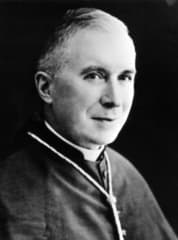アヴェ・マリア・インマクラータ!
愛する兄弟姉妹の皆様、
レネー神父様の霊的講話 「ご聖体の秘蹟について:その3)聖体拝領」(日本語訳)をご紹介いたします。
天主様の祝福が豊かにありますように!
トマス小野田圭志神父(聖ピオ十世会司祭)
親愛なる兄弟の皆さん、
私たちは前回まで、ご聖体の秘蹟に、私たちの主イエズス・キリストが犠牲のいけにえとして真実かつ実体的に現存なさっており、そのためミサは教会の最も素晴らしい宝であるということを見てきました。でも、まださらに驚くべきことがあります。私たちの主イエズス・キリストは、主の御体と御血に変化させられるご聖体の質料として、パンとぶどう酒を選ばれました。それは、主の犠牲を祭壇上で行い、すべてのミサでそれを御父にお捧げするためだけでなく、さらに私たちが、主の犠牲の最も完全な実である主の御体と御血を本当に食べることができ、それによってここ地上で可能な限り完全に私たちが主との一致に到達できるようにするためでもありました。ですから、聖体拝領は犠牲の実、命の木すなわち十字架の実なのです。聖体拝領は、よく準備されていれば、自分をミサと一致させる最高の方法であるのは疑いありません。
洗礼が霊的な命の始まりの秘蹟、私たちのうちにおけるキリストの命の始まりの秘蹟であり、そのため新たな誕生に例えられるように、ご聖体は、まことの天主にしてまことの人間である私たちの主イエズス・キリストとの完全な一致から成る、霊的な命の目的の秘蹟でありかつ最終的な完成の秘蹟です。これは、ご聖体を受けるために完全である必要があるという意味ではなく、むしろ良き聖体拝領は私たちを完全へと導くという意味です。聖体拝領は、私たちが完全へと進んでいくよう、私たちに与えられた最も優れた手段です。
私たちには完全へと向かう義務があります。実際、私たちの主イエズス・キリストはこう言われました。「あなたたちの天の父が完全であるようにあなたたちも完全な者になれ」(マテオ5章48節)。また聖パウロは私たちにこう勧告します。「それでは兄弟たちよ、喜べ、完全であれ、朗らかであれ、心を一つにせよ、平和に生きよ。そうすれば、愛と平和の天主はあなたたちとともにましますであろう」(コリント後書13章11節)。最も重大な天主の掟である第一戒は実際、完全を命じる掟です。「あなたはすべての心、すべての霊、すべての知恵、すべての力をあげて、主なる天主を愛せよ」(マルコ12章30節)。
さて、その完全な愛は、天主の御心およびご意志との完全な一致から成っています。聖ヨハネはこう言います。「天主は愛である。愛を持つ者は天主にとどまり[宿り]、天主は彼にとどまられる[宿られる]」(ヨハネ第一4章16節)。また、これこそがまさにご聖体の実です。「私の肉を食べ私の血を飲む者は、私に宿り、私もまたその者のうちに宿る」(ヨハネ6章56節)。
聖体拝領から十分に利益を得るためには、良き準備が必要です。まず第一の条件が大変重要であり、絶対に必要不可欠です。それは、ご聖体を受けるためには成聖の恩寵の状態でなければならないことです。ご聖体は「(霊的に)生きている人の秘蹟」であり、すなわち成聖の恩寵の状態を要求するのです。成聖の恩寵の状態にないならば、その人には最初の場合は洗礼が必要であり、あるいは洗礼ののち大罪に陥ったのであれば悔悛の秘蹟が必要です。大罪の状態にあればご聖体を受けることが許されていないだけでなく、決して受けてはいけません。受けることは汚聖という重い罪になります。天主からの最も素晴らしい賜物にひどい扱いをするそのような汚聖は、真理に対して、善に対して精神を盲目にし、その結果、霊魂と心を固くさせてしまい、最後には破滅へと至らせるでしょう。その反対に、罪びとが主に対する十分な信仰と敬意を持ち、聖体拝領を控えるならば、その敬意がその人を助けて、まことの痛悔の恩寵を得させ、それによってその人を良き告解へと導き、そののち―そののちに限りますが―実り豊かにご聖体を受けることができるように導くのです。
非常に多くの人々が毎回のミサで聖体拝領に行きながらほとんど告解に行かないという私たちの時代には、まことに恐るべきことである悪しき聖体拝領が増えています。何年も告解に行っていないのに、恐れもなくご聖体に近づく人々がいます。聖パウロは、そのような汚聖の罪の重さについてはっきりと言っています。「主のお体をわきまえずに飲食する者は、自分自身への裁きを飲食することである」(コリント前書11章29節)のであり、その者は「主のお体と御血を犯す」(コリント前書11章27節)のです。この文脈では、「裁き」とは地獄の宣告のことです。聖書のこの節は、新しいミサではもはや読み上げられないことに注意してください。彼らは聖パウロのコリント人への書簡にあるこの最後の三つの節[第27-29節]を削除し、第26節で朗読をやめ、ご聖体にまします私たちの主イエズス・キリストの真実について最も明確に述べているこの三つの節を省略してしまったのです。
第二の条件は「正しい意向」です。これはただ他のみんなと同じようにするためというのではなく、主にもっと近づくため、霊的な命(生活)においてもっと強くなるため、私たちの主イエズス・キリストともっともっと一致するためです。その意向をはっきりと表明することは有益ですが、必ずしも必要ではありません。「事実上の」意向で事足ります。私がこう言うのは、皆さんがその意向をはっきりと更新しなかった場合にも気をとがめることがないようにするためです。天主をもっともっと愛したいという習慣的な意向があれば十分です。しかし、ときどき混じっていることのある、この世的な動機は避けることが大事です。
必要な第三の条件は、聖体拝領前の断食です。教会の古くからの慣習は、聖体拝領前の真夜中から断食することです。人々が早朝のミサに行くことができないような仕事時間という現代世界の困難を考慮して、教皇ピオ十二世は夕べのミサを許可し、この夕べのミサでの聖体拝領をも促すために「三時間の聖体拝領前の断食」を許可しました。これは固形食物やアルコール飲料は禁じましたが、水以外の液体飲料については一時間の断食としました。水は飲んでも断食に反しません。本物の薬は飲んでも断食に反しません。私は本物の薬と言いましたが、その理由は「ダイエット用のサプリメント」は薬ではなくむしろ食物であり、そのため、それが薬のようにカプセルに入っていたとしても聖体拝領前の断食に反するからです。
頻繁な聖体拝領に関する教令の中で、聖ピオ十世は、上記の三つの条件で十分であるとしています。成聖の恩寵の状態、正しい意向、聖体拝領前の断食です。しかしながら、聖体拝領への準備を良くすればするほど、もっと多くの恩寵を受けること、また、聖体拝領では恩寵の創り主そのものであるお方、私たちの主イエズス・キリストを受けるのですから、その恩寵の量には制限がないということも知っておく必要があります。「恩寵と真理はイエズス・キリストによって来た」(ヨハネ1章17節)のです。ですから、聖体拝領の直前の準備は非常に重要です。ミサの儀式全体が霊魂に対してふさわしい準備をさせます。ですからイエズスへの大きな渇望をもって教会の精神の中に本当に入らなければならず、そうすれば教会の祈りによって支えられて素晴らしい準備へと至るでしょう。
この直前の準備の本質は、信仰と愛徳のわざにあります。すなわちご聖体にまします私たちの主イエズス・キリストを観想することと、主を熱心に求めることです。主は天使たちの食べ物です。詩篇作者はこう言います。「人は天使たちのパンを食べた」(詩篇77章25節)。聖なる天使たちは、真理であり命である私たちの主イエズス・キリストのご神性そのものを見ています。天使たちは、この天主の真理によって照らされ、この天主の命を生きています。そしてこのイエズス、私たちの救いのために肉体となられた天主の永遠のみ言葉であるお方は、主の御血、ご霊魂、ご神性とともにその肉そのものを私たちに食べさせるよう、ご自分を私たちにお与えになっているのです。知恵の書は天主の惜しみのなさをこう歌います。「あなたはみ民に対しては天使の食べ物を与えられ、労苦しないでもパンを降らされた。それは、あらゆる楽しみのもととなり、あらゆる味覚を満たすものだった」(知恵16章20節)。「私は天から下った生きるパンである。このパンを食べる者は永遠に生きる。私の与えるパンは、世の命のためにわたされる私の肉である」(ヨハネ6章51-52節)。
聖体拝領は、本当に私たちの望みと必要を私たちの主に願い出る時です。他のどの時よりも、その時こそ、「求めよ、そうすれば与えられる。探せ、そうすれば見いだす。たたけ、そうすれば開かれる」(マテオ7章7節)のです。皆さんにご自分の御独り子をお与えになるお方は、御子とともにあらゆる恩寵を皆さんにお与えになるでしょう。「ご自分のみ子を惜しまずに私たちすべてのためにわたされたお方が、み子とともに他のすべてを下さらないはずがあろうか」(ローマ8章32節)。聖体拝領は、私たち自身のためだけでなく、私たちにとって大事なすべての人々のため、私たちの近くにいるすべての人々のため、教会の必要とするすべてのもののため、罪びとの回心などのためにもお願いをする時です。地上のものごとを願うのは許されていますが、単に地上のものごとだけを願うべきではなく、そうするのは間違っています。なによりも第一に霊的なこと、徳、誘惑に対する勝利、信心、そして私たちを天主に本当に結びつけるものすべてを願うべきです。そのような祈願は聖体拝領の前後両方で行うことができます。
聖体拝領の時は、最も重要です。聖アウグスティノはこう言っています。「先にこれを礼拝しない者は、誰もこの肉を食べてはならない…われわれは礼拝することによって罪を犯さないだけでなく、それを礼拝しないならば罪を犯すのである」。ですから、教会の最も古い時代から、聖体拝領の時に信者は主を礼拝してきました。これは、ローマ典礼においては、伝統的にひざまずいて舌でご聖体を受ける方法で行われます。手による聖体拝領は、多くの霊魂に対して本当につまずきを与えるものです。その人が信仰と礼拝という内的な行いをしているとしても、聖アウグスティノが教え、彼とともに全教会が教えたような、キリストに当然捧げるべき外的な礼拝をしていないのです。ですから、ご聖体を受ける聖伝の方法は、恩寵に対して、キリストに対して霊魂を開くために非常に重要です。聖ヤコボはこう言っています。「天主はおごる者に逆らい、へりくだる者を恵まれる」(ヤコボ4章6節)。その反対に、手による聖体拝領という現代的方法は敬意に欠けていることが何度も何度も明らかになっており、それは恩寵に対して霊魂を閉ざし、神学者たちが「閂(かんぬき)」と呼ぶもの、すなわち恩寵に対する障害物となるのです。
直前の準備が非常に重要であるように、聖体拝領後の良き感謝も重要です。聖体拝領においてイエズスを受けたのち、十分黙想して熱心に祈るべきです。これらは一日全体で、一週間全体で、また実際、私たちの人生全体で最も重要な時です。聖体拝領ののち、ミサが終わる前にも、すぐ急いで教会から出ないでください。そうすることは非常に間違っています。主に対して適切でふさわしい感謝の時間を是非持ってください。通常は、十五分間程度の良き感謝の時間を持つべきだと言われています。
この感謝はその後も、その一日中の雰囲気として、続けるべきです。私たちは、天主の御子である私たちの主イエズス・キリストを受けたのですから! 私たちはいったいどうしたら、天主を知らない異邦人のように生きることができますか? できるはずがありません! これからは、これまで以上に私たちは主にふさわしくあらねばなりません。聖パウロが言うように、私たちは次のように言うことができなければなりません。「私は生きているが、もう私ではなく、キリストが私の内に生き給うのである。私は肉体をもって生きているが、私を愛し、私のためにご自身をわたされた天主の子への信仰の中に生きている」(ガラツィア2章20節)。「私にとって生きるのはキリストであり、死は利益である」(フィリッピ1章21節)。
聖体拝領の最高の模範は童貞聖マリアです。実際、私たちが受けるご聖体は、九カ月の間聖母のいとも清らかなご胎内に住まわれたのと同じキリストの御体なのですから。「み言葉は肉体となって、」聖母のうちに「住まわれた」(ヨハネ1章14節)とき、聖母はご自分のうちに私たちの主イエズス・キリストの御体、御血、ご霊魂、ご神性を本当に受けられました。聖母は最初の生けるご聖櫃となられたのでした。どのような信仰をもって、どのような信心をもって、どのような謙遜をもって、どのように強い愛をもって、聖母はイエズスを受けられ、イエズスをそのご胎内に保っておられたのでしょうか! 聖母の思いはどのようなものだったのでしょうか? イエズスに対する聖母の愛はどのようなものだったのでしょうか? 聖母を観想すればするほど、私たちは自分がどうすべきかということについてもっと学びます。これらすべての徳をいただけるよう聖母に願いましょう。聖母が私たちの足らないところを補ってくださり、聖母がイエズスに捧げられた信仰と礼拝のすべての行いを私たちがイエズスに捧げることができるよう聖母に願いましょう。
聖ピオ十世は、頻繁にご聖体を受けるという古い慣習を復興されました。これは実際、特に西方では古い慣習で、毎日ミサに参列してご聖体を受けるという慣習でした。主はまことに、私たちが聖マテオによる『主の祈り』でお願いする私たちの「日用の糧」なのです。「われらの日用の糧を今日われらに与え給え」(マテオ6章11節)。それは地上のパンではなく、むしろ「天から下ったパン」(ヨハネ6章58節)、すなわち私たちの主イエズス・キリストの御体そのものなのです。でも、聖伝に従えば、信者がご聖体を受けるのは一日に一回だけです。一日に一回を超える聖体拝領を許している現代の慣例は、ミサが単なる食事であり、食べない限り本当に食事にあずかっていないという近代主義者の思想から来ているのです。それゆえに、彼らは誰もが毎回のミサでご聖体を受けるよう推し進めているのです。しかし、ミサは本質的には犠牲であり、新約の犠牲です。さて、旧約では、いけにえを食べる犠牲もあり、食べない犠牲もありましたが、信心をもってその犠牲に参加すれば、その信心によってその犠牲からの利益を十分に受けていたのです。
ご聖体は、特に命の終わりにおいては、永遠の交わりの準備をするために非常に重要です。死にゆく者に与えられるこのご聖体は「聖なる旅路の糧」と呼ばれ、人はそれを求め、またそれを受ける恩寵があるよう祈るべきです。病気になって教会に行けなくなった場合、司祭に依頼して、自分のためにご聖体にまします私たちの主を持って来てもらうようにすべきです。ご聖体は病気のときは非常に大きな慰めになり、特に自分の苦しみを主の御苦しみと一致させるのを助けてくれ、その苦しみを恩寵の素晴らしい源に変えてくれるのです。
ご聖体は、子どもでも主を受けることが可能になればすぐに授けることができます。聖ピオ十世は、子どもたちがご聖体と普通の食べ物の違いを知ることを要求されています。子どもたちは、基本的なカテキズムを知る必要があります。子どもたちに遅くならないうちにうまく教えがなされれば、彼らは七歳の若さでも、あるいはさらに早くともイエズスを受けることができるはずです。多くの場合、初聖体が九歳かあるいは十歳までも遅れるのを見ますが、これはこんにち、カテキズム教育の実施が昔より大きく減ってしまっていることのしるしです。良き親たちは子どもたちに、早期からのカテキズム教育をするのを心掛けるべきです。そうすれば、子どもたちがご聖体から大きな利益を得るのを遅らせてしまうことはないでしょう。思春期に迎える試練を堕落せず勝利をもって通り抜けるために、子どもたちにはこの素晴らしい秘蹟から受ける助けが必要なのです。早くからご聖体にましますイエズスへの愛があれば、しばしばその愛とともに召命の恩寵がもたらされるでしょう。子どもたちの初聖体への準備を怠れば、罪を免れません。
諸聖人は聖体拝領を愛してきました。聖体拝領は彼らにとって一日のうちで最も素晴らしい時であり、その時を熱望し、その時のために生きていたのです。聖体拝領後の彼らの黙想は、ときどき本当に驚くべきものでした。聖ドミニコ・サヴィオが思いだされます。私の記憶が正しければ、彼は他のみんなが教会を出ていったあとでも、感謝の祈りを捧げていました。あまりにも主に愛着していたため、他のすべてのことを完全に忘れていたのです。聖イメルダの場合は、聖体拝領のあと愛のために亡くなったのです!
童貞聖マリアとこれら諸聖人が、私たち全員がこれほど素晴らしい秘蹟を受ける準備をし、完全にその秘蹟を生きることができるよう助けてくださいますように。その結果、私たちが天国で顔と顔を合わせる永遠の交わり(聖体拝領)に到達することができますように! アーメン。
愛する兄弟姉妹の皆様、
レネー神父様の霊的講話 「ご聖体の秘蹟について:その3)聖体拝領」(日本語訳)をご紹介いたします。
天主様の祝福が豊かにありますように!
トマス小野田圭志神父(聖ピオ十世会司祭)
2017年1月15日 御公現後の第2主日―大阪
「ご聖体の秘蹟について」:その3)聖体拝領
「ご聖体の秘蹟について」:その3)聖体拝領
親愛なる兄弟の皆さん、
私たちは前回まで、ご聖体の秘蹟に、私たちの主イエズス・キリストが犠牲のいけにえとして真実かつ実体的に現存なさっており、そのためミサは教会の最も素晴らしい宝であるということを見てきました。でも、まださらに驚くべきことがあります。私たちの主イエズス・キリストは、主の御体と御血に変化させられるご聖体の質料として、パンとぶどう酒を選ばれました。それは、主の犠牲を祭壇上で行い、すべてのミサでそれを御父にお捧げするためだけでなく、さらに私たちが、主の犠牲の最も完全な実である主の御体と御血を本当に食べることができ、それによってここ地上で可能な限り完全に私たちが主との一致に到達できるようにするためでもありました。ですから、聖体拝領は犠牲の実、命の木すなわち十字架の実なのです。聖体拝領は、よく準備されていれば、自分をミサと一致させる最高の方法であるのは疑いありません。
洗礼が霊的な命の始まりの秘蹟、私たちのうちにおけるキリストの命の始まりの秘蹟であり、そのため新たな誕生に例えられるように、ご聖体は、まことの天主にしてまことの人間である私たちの主イエズス・キリストとの完全な一致から成る、霊的な命の目的の秘蹟でありかつ最終的な完成の秘蹟です。これは、ご聖体を受けるために完全である必要があるという意味ではなく、むしろ良き聖体拝領は私たちを完全へと導くという意味です。聖体拝領は、私たちが完全へと進んでいくよう、私たちに与えられた最も優れた手段です。
私たちには完全へと向かう義務があります。実際、私たちの主イエズス・キリストはこう言われました。「あなたたちの天の父が完全であるようにあなたたちも完全な者になれ」(マテオ5章48節)。また聖パウロは私たちにこう勧告します。「それでは兄弟たちよ、喜べ、完全であれ、朗らかであれ、心を一つにせよ、平和に生きよ。そうすれば、愛と平和の天主はあなたたちとともにましますであろう」(コリント後書13章11節)。最も重大な天主の掟である第一戒は実際、完全を命じる掟です。「あなたはすべての心、すべての霊、すべての知恵、すべての力をあげて、主なる天主を愛せよ」(マルコ12章30節)。
さて、その完全な愛は、天主の御心およびご意志との完全な一致から成っています。聖ヨハネはこう言います。「天主は愛である。愛を持つ者は天主にとどまり[宿り]、天主は彼にとどまられる[宿られる]」(ヨハネ第一4章16節)。また、これこそがまさにご聖体の実です。「私の肉を食べ私の血を飲む者は、私に宿り、私もまたその者のうちに宿る」(ヨハネ6章56節)。
聖体拝領から十分に利益を得るためには、良き準備が必要です。まず第一の条件が大変重要であり、絶対に必要不可欠です。それは、ご聖体を受けるためには成聖の恩寵の状態でなければならないことです。ご聖体は「(霊的に)生きている人の秘蹟」であり、すなわち成聖の恩寵の状態を要求するのです。成聖の恩寵の状態にないならば、その人には最初の場合は洗礼が必要であり、あるいは洗礼ののち大罪に陥ったのであれば悔悛の秘蹟が必要です。大罪の状態にあればご聖体を受けることが許されていないだけでなく、決して受けてはいけません。受けることは汚聖という重い罪になります。天主からの最も素晴らしい賜物にひどい扱いをするそのような汚聖は、真理に対して、善に対して精神を盲目にし、その結果、霊魂と心を固くさせてしまい、最後には破滅へと至らせるでしょう。その反対に、罪びとが主に対する十分な信仰と敬意を持ち、聖体拝領を控えるならば、その敬意がその人を助けて、まことの痛悔の恩寵を得させ、それによってその人を良き告解へと導き、そののち―そののちに限りますが―実り豊かにご聖体を受けることができるように導くのです。
非常に多くの人々が毎回のミサで聖体拝領に行きながらほとんど告解に行かないという私たちの時代には、まことに恐るべきことである悪しき聖体拝領が増えています。何年も告解に行っていないのに、恐れもなくご聖体に近づく人々がいます。聖パウロは、そのような汚聖の罪の重さについてはっきりと言っています。「主のお体をわきまえずに飲食する者は、自分自身への裁きを飲食することである」(コリント前書11章29節)のであり、その者は「主のお体と御血を犯す」(コリント前書11章27節)のです。この文脈では、「裁き」とは地獄の宣告のことです。聖書のこの節は、新しいミサではもはや読み上げられないことに注意してください。彼らは聖パウロのコリント人への書簡にあるこの最後の三つの節[第27-29節]を削除し、第26節で朗読をやめ、ご聖体にまします私たちの主イエズス・キリストの真実について最も明確に述べているこの三つの節を省略してしまったのです。
第二の条件は「正しい意向」です。これはただ他のみんなと同じようにするためというのではなく、主にもっと近づくため、霊的な命(生活)においてもっと強くなるため、私たちの主イエズス・キリストともっともっと一致するためです。その意向をはっきりと表明することは有益ですが、必ずしも必要ではありません。「事実上の」意向で事足ります。私がこう言うのは、皆さんがその意向をはっきりと更新しなかった場合にも気をとがめることがないようにするためです。天主をもっともっと愛したいという習慣的な意向があれば十分です。しかし、ときどき混じっていることのある、この世的な動機は避けることが大事です。
必要な第三の条件は、聖体拝領前の断食です。教会の古くからの慣習は、聖体拝領前の真夜中から断食することです。人々が早朝のミサに行くことができないような仕事時間という現代世界の困難を考慮して、教皇ピオ十二世は夕べのミサを許可し、この夕べのミサでの聖体拝領をも促すために「三時間の聖体拝領前の断食」を許可しました。これは固形食物やアルコール飲料は禁じましたが、水以外の液体飲料については一時間の断食としました。水は飲んでも断食に反しません。本物の薬は飲んでも断食に反しません。私は本物の薬と言いましたが、その理由は「ダイエット用のサプリメント」は薬ではなくむしろ食物であり、そのため、それが薬のようにカプセルに入っていたとしても聖体拝領前の断食に反するからです。
頻繁な聖体拝領に関する教令の中で、聖ピオ十世は、上記の三つの条件で十分であるとしています。成聖の恩寵の状態、正しい意向、聖体拝領前の断食です。しかしながら、聖体拝領への準備を良くすればするほど、もっと多くの恩寵を受けること、また、聖体拝領では恩寵の創り主そのものであるお方、私たちの主イエズス・キリストを受けるのですから、その恩寵の量には制限がないということも知っておく必要があります。「恩寵と真理はイエズス・キリストによって来た」(ヨハネ1章17節)のです。ですから、聖体拝領の直前の準備は非常に重要です。ミサの儀式全体が霊魂に対してふさわしい準備をさせます。ですからイエズスへの大きな渇望をもって教会の精神の中に本当に入らなければならず、そうすれば教会の祈りによって支えられて素晴らしい準備へと至るでしょう。
この直前の準備の本質は、信仰と愛徳のわざにあります。すなわちご聖体にまします私たちの主イエズス・キリストを観想することと、主を熱心に求めることです。主は天使たちの食べ物です。詩篇作者はこう言います。「人は天使たちのパンを食べた」(詩篇77章25節)。聖なる天使たちは、真理であり命である私たちの主イエズス・キリストのご神性そのものを見ています。天使たちは、この天主の真理によって照らされ、この天主の命を生きています。そしてこのイエズス、私たちの救いのために肉体となられた天主の永遠のみ言葉であるお方は、主の御血、ご霊魂、ご神性とともにその肉そのものを私たちに食べさせるよう、ご自分を私たちにお与えになっているのです。知恵の書は天主の惜しみのなさをこう歌います。「あなたはみ民に対しては天使の食べ物を与えられ、労苦しないでもパンを降らされた。それは、あらゆる楽しみのもととなり、あらゆる味覚を満たすものだった」(知恵16章20節)。「私は天から下った生きるパンである。このパンを食べる者は永遠に生きる。私の与えるパンは、世の命のためにわたされる私の肉である」(ヨハネ6章51-52節)。
聖体拝領は、本当に私たちの望みと必要を私たちの主に願い出る時です。他のどの時よりも、その時こそ、「求めよ、そうすれば与えられる。探せ、そうすれば見いだす。たたけ、そうすれば開かれる」(マテオ7章7節)のです。皆さんにご自分の御独り子をお与えになるお方は、御子とともにあらゆる恩寵を皆さんにお与えになるでしょう。「ご自分のみ子を惜しまずに私たちすべてのためにわたされたお方が、み子とともに他のすべてを下さらないはずがあろうか」(ローマ8章32節)。聖体拝領は、私たち自身のためだけでなく、私たちにとって大事なすべての人々のため、私たちの近くにいるすべての人々のため、教会の必要とするすべてのもののため、罪びとの回心などのためにもお願いをする時です。地上のものごとを願うのは許されていますが、単に地上のものごとだけを願うべきではなく、そうするのは間違っています。なによりも第一に霊的なこと、徳、誘惑に対する勝利、信心、そして私たちを天主に本当に結びつけるものすべてを願うべきです。そのような祈願は聖体拝領の前後両方で行うことができます。
聖体拝領の時は、最も重要です。聖アウグスティノはこう言っています。「先にこれを礼拝しない者は、誰もこの肉を食べてはならない…われわれは礼拝することによって罪を犯さないだけでなく、それを礼拝しないならば罪を犯すのである」。ですから、教会の最も古い時代から、聖体拝領の時に信者は主を礼拝してきました。これは、ローマ典礼においては、伝統的にひざまずいて舌でご聖体を受ける方法で行われます。手による聖体拝領は、多くの霊魂に対して本当につまずきを与えるものです。その人が信仰と礼拝という内的な行いをしているとしても、聖アウグスティノが教え、彼とともに全教会が教えたような、キリストに当然捧げるべき外的な礼拝をしていないのです。ですから、ご聖体を受ける聖伝の方法は、恩寵に対して、キリストに対して霊魂を開くために非常に重要です。聖ヤコボはこう言っています。「天主はおごる者に逆らい、へりくだる者を恵まれる」(ヤコボ4章6節)。その反対に、手による聖体拝領という現代的方法は敬意に欠けていることが何度も何度も明らかになっており、それは恩寵に対して霊魂を閉ざし、神学者たちが「閂(かんぬき)」と呼ぶもの、すなわち恩寵に対する障害物となるのです。
直前の準備が非常に重要であるように、聖体拝領後の良き感謝も重要です。聖体拝領においてイエズスを受けたのち、十分黙想して熱心に祈るべきです。これらは一日全体で、一週間全体で、また実際、私たちの人生全体で最も重要な時です。聖体拝領ののち、ミサが終わる前にも、すぐ急いで教会から出ないでください。そうすることは非常に間違っています。主に対して適切でふさわしい感謝の時間を是非持ってください。通常は、十五分間程度の良き感謝の時間を持つべきだと言われています。
この感謝はその後も、その一日中の雰囲気として、続けるべきです。私たちは、天主の御子である私たちの主イエズス・キリストを受けたのですから! 私たちはいったいどうしたら、天主を知らない異邦人のように生きることができますか? できるはずがありません! これからは、これまで以上に私たちは主にふさわしくあらねばなりません。聖パウロが言うように、私たちは次のように言うことができなければなりません。「私は生きているが、もう私ではなく、キリストが私の内に生き給うのである。私は肉体をもって生きているが、私を愛し、私のためにご自身をわたされた天主の子への信仰の中に生きている」(ガラツィア2章20節)。「私にとって生きるのはキリストであり、死は利益である」(フィリッピ1章21節)。
聖体拝領の最高の模範は童貞聖マリアです。実際、私たちが受けるご聖体は、九カ月の間聖母のいとも清らかなご胎内に住まわれたのと同じキリストの御体なのですから。「み言葉は肉体となって、」聖母のうちに「住まわれた」(ヨハネ1章14節)とき、聖母はご自分のうちに私たちの主イエズス・キリストの御体、御血、ご霊魂、ご神性を本当に受けられました。聖母は最初の生けるご聖櫃となられたのでした。どのような信仰をもって、どのような信心をもって、どのような謙遜をもって、どのように強い愛をもって、聖母はイエズスを受けられ、イエズスをそのご胎内に保っておられたのでしょうか! 聖母の思いはどのようなものだったのでしょうか? イエズスに対する聖母の愛はどのようなものだったのでしょうか? 聖母を観想すればするほど、私たちは自分がどうすべきかということについてもっと学びます。これらすべての徳をいただけるよう聖母に願いましょう。聖母が私たちの足らないところを補ってくださり、聖母がイエズスに捧げられた信仰と礼拝のすべての行いを私たちがイエズスに捧げることができるよう聖母に願いましょう。
聖ピオ十世は、頻繁にご聖体を受けるという古い慣習を復興されました。これは実際、特に西方では古い慣習で、毎日ミサに参列してご聖体を受けるという慣習でした。主はまことに、私たちが聖マテオによる『主の祈り』でお願いする私たちの「日用の糧」なのです。「われらの日用の糧を今日われらに与え給え」(マテオ6章11節)。それは地上のパンではなく、むしろ「天から下ったパン」(ヨハネ6章58節)、すなわち私たちの主イエズス・キリストの御体そのものなのです。でも、聖伝に従えば、信者がご聖体を受けるのは一日に一回だけです。一日に一回を超える聖体拝領を許している現代の慣例は、ミサが単なる食事であり、食べない限り本当に食事にあずかっていないという近代主義者の思想から来ているのです。それゆえに、彼らは誰もが毎回のミサでご聖体を受けるよう推し進めているのです。しかし、ミサは本質的には犠牲であり、新約の犠牲です。さて、旧約では、いけにえを食べる犠牲もあり、食べない犠牲もありましたが、信心をもってその犠牲に参加すれば、その信心によってその犠牲からの利益を十分に受けていたのです。
ご聖体は、特に命の終わりにおいては、永遠の交わりの準備をするために非常に重要です。死にゆく者に与えられるこのご聖体は「聖なる旅路の糧」と呼ばれ、人はそれを求め、またそれを受ける恩寵があるよう祈るべきです。病気になって教会に行けなくなった場合、司祭に依頼して、自分のためにご聖体にまします私たちの主を持って来てもらうようにすべきです。ご聖体は病気のときは非常に大きな慰めになり、特に自分の苦しみを主の御苦しみと一致させるのを助けてくれ、その苦しみを恩寵の素晴らしい源に変えてくれるのです。
ご聖体は、子どもでも主を受けることが可能になればすぐに授けることができます。聖ピオ十世は、子どもたちがご聖体と普通の食べ物の違いを知ることを要求されています。子どもたちは、基本的なカテキズムを知る必要があります。子どもたちに遅くならないうちにうまく教えがなされれば、彼らは七歳の若さでも、あるいはさらに早くともイエズスを受けることができるはずです。多くの場合、初聖体が九歳かあるいは十歳までも遅れるのを見ますが、これはこんにち、カテキズム教育の実施が昔より大きく減ってしまっていることのしるしです。良き親たちは子どもたちに、早期からのカテキズム教育をするのを心掛けるべきです。そうすれば、子どもたちがご聖体から大きな利益を得るのを遅らせてしまうことはないでしょう。思春期に迎える試練を堕落せず勝利をもって通り抜けるために、子どもたちにはこの素晴らしい秘蹟から受ける助けが必要なのです。早くからご聖体にましますイエズスへの愛があれば、しばしばその愛とともに召命の恩寵がもたらされるでしょう。子どもたちの初聖体への準備を怠れば、罪を免れません。
諸聖人は聖体拝領を愛してきました。聖体拝領は彼らにとって一日のうちで最も素晴らしい時であり、その時を熱望し、その時のために生きていたのです。聖体拝領後の彼らの黙想は、ときどき本当に驚くべきものでした。聖ドミニコ・サヴィオが思いだされます。私の記憶が正しければ、彼は他のみんなが教会を出ていったあとでも、感謝の祈りを捧げていました。あまりにも主に愛着していたため、他のすべてのことを完全に忘れていたのです。聖イメルダの場合は、聖体拝領のあと愛のために亡くなったのです!
童貞聖マリアとこれら諸聖人が、私たち全員がこれほど素晴らしい秘蹟を受ける準備をし、完全にその秘蹟を生きることができるよう助けてくださいますように。その結果、私たちが天国で顔と顔を合わせる永遠の交わり(聖体拝領)に到達することができますように! アーメン。










